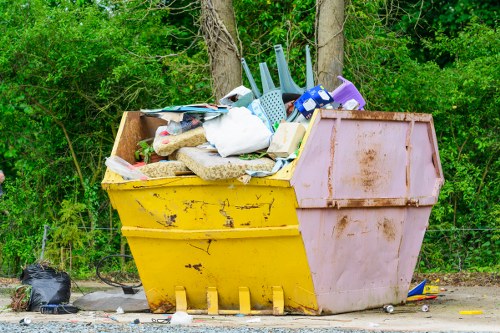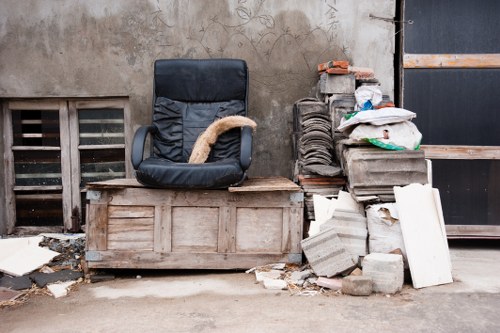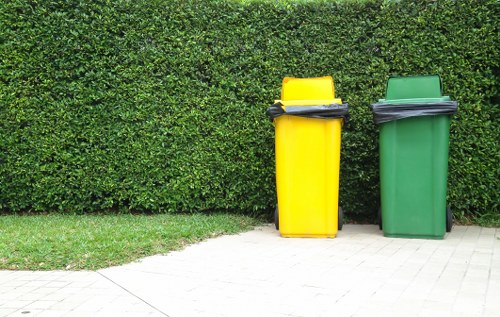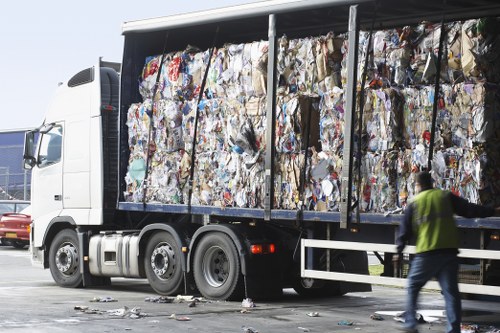Furniture Clearance in Commercial Waste Collection

Commercial spaces frequently undergo renovations, relocations, or simply need to declutter to maintain efficiency. One of the critical aspects of maintaining a streamlined commercial environment is efficient furniture clearance. Proper furniture clearance not only ensures a clean and organized workspace but also plays a significant role in sustainable waste management.
When businesses decide to update their interior or downsize, the volume of unwanted furniture can be overwhelming. Efficient furniture clearance services are essential to handle this influx, ensuring that old or unused items are disposed of responsibly. This process involves removal, recycling, and, where possible, repurposing furniture to minimize environmental impact.
Understanding the nuances of commercial waste collection for furniture clearance can save businesses time, money, and contribute positively to environmental conservation. In this article, we delve into the comprehensive strategies and best practices involved in effective furniture clearance within commercial settings.
Understanding Commercial Furniture Clearance

Commercial furniture clearance refers to the systematic removal of office furniture, fixtures, and equipment (often abbreviated as FF&E) from business premises. This process is typically necessary during major transitions such as office relocations, renovations, downsizing, or liquidation.
Effective clearance goes beyond mere removal; it encompasses sorting, recycling, donating, and disposing of furniture responsibly. Businesses must consider factors such as the condition of the furniture, potential for reuse, and compliance with environmental regulations when planning clearance operations.
Moreover, professional furniture clearance services can offer tailored solutions that address the unique needs of different commercial entities, ensuring minimal disruption to ongoing operations. By leveraging expertise in logistics and waste management, these services facilitate a smooth transition, enabling businesses to focus on their core activities.
Importance of Sustainable Furniture Clearance

Sustainability has become a cornerstone of modern business practices. In the context of furniture clearance, sustainability involves reducing waste, promoting recycling, and ensuring that disposed items have a second life, either through donation or resale.
By opting for sustainable clearance methods, businesses can significantly reduce their environmental footprint. This not only aligns with corporate social responsibility goals but also enhances the company's reputation as an environmentally conscious entity.
Additionally, sustainable furniture clearance can lead to cost savings. Recycling and donating furniture can often be less expensive than traditional disposal methods. Moreover, some clearance services may offer tax benefits for donations, further incentivizing businesses to choose eco-friendly options.
Steps Involved in Furniture Clearance

Effective furniture clearance involves a series of methodical steps to ensure that the process is efficient, compliant, and environmentally responsible.
- Assessment: Evaluate the volume and types of furniture to be cleared. Determine the condition of each item to decide whether it can be reused, recycled, or needs disposal.
- Planning: Develop a clearance plan that outlines the timeline, resources required, and any specific handling instructions for delicate or valuable items.
- Sorting: Categorize furniture into different groups based on their condition and potential for reuse or recycling.
- Removal: Safely transport the furniture from the commercial premises to designated recycling centers, donation points, or disposal facilities.
- Disposal: Ensure that all disposed items comply with local environmental regulations and that hazardous materials are handled appropriately.
Choosing the Right Furniture Clearance Service

Selecting a reliable furniture clearance service is crucial for a seamless clearance process. Here are key factors to consider:
- Experience and Expertise: Opt for companies with a proven track record in commercial furniture clearance. Experienced services are better equipped to handle diverse clearance challenges.
- Environmental Practices: Ensure that the service adheres to sustainable practices, such as recycling and donating reusable items.
- Comprehensive Services: Look for providers that offer end-to-end solutions, including assessment, planning, removal, and disposal.
- Cost-Effectiveness: Compare quotes from multiple services to find a balance between cost and quality of service.
- Customer Reviews: Check testimonials and reviews to gauge the reliability and efficiency of the clearance service.
Benefits of Professional Furniture Clearance

Engaging professional furniture clearance services offers numerous benefits to businesses:
- Time-Saving: Professionals handle all aspects of clearance, allowing businesses to focus on their operations without disruption.
- Safety: Proper handling and removal of furniture reduce the risk of workplace accidents.
- Compliance: Experts ensure that all clearance activities comply with local waste management regulations.
- Cost Efficiency: Avoid hidden costs associated with DIY clearance, such as labor, transportation, and disposal fees.
- Environmental Impact: Professional services are more likely to implement sustainable practices, reducing the overall environmental footprint.
Environmental Regulations and Compliance

Compliance with environmental laws is a critical aspect of commercial furniture clearance. Businesses must adhere to regulations governing the disposal and recycling of waste materials to avoid legal repercussions and environmental harm.
Key regulations may include:
- Waste Disposal Laws: Govern how waste must be handled, stored, and transported to prevent pollution.
- Recycling Requirements: Mandate the segregation and recycling of certain materials to promote sustainability.
- Hazardous Waste Management: Define procedures for safely disposing of items containing hazardous substances.
Professional clearance services stay updated with these regulations and ensure that all clearance activities are compliant, mitigating legal risks for businesses.
Recycling and Repurposing Furniture

Recycling and repurposing are integral to sustainable furniture clearance. By redirecting usable furniture from landfills, businesses contribute to resource conservation and environmental protection.
Many clearance services collaborate with recycling centers and charitable organizations to ensure that furniture in good condition finds a new home. This approach not only reduces waste but also supports communities in need.
Furthermore, repurposing involves creatively transforming old furniture into new, functional pieces, extending their lifecycle and reducing the demand for new manufacturing resources. This practice aligns with the principles of a circular economy, where products are reused and recycled continuously.
Cost Considerations in Furniture Clearance

Budgeting for furniture clearance is an essential aspect of the process. Several factors influence the overall cost, including:
- Volume of Furniture: Larger quantities require more resources, increasing costs.
- Type of Items: Delicate or heavy furniture may incur additional handling fees.
- Distance: The distance between the commercial premises and disposal or recycling centers affects transportation costs.
- Service Level: Comprehensive services that include sorting, cleaning, and organizing may be more expensive but offer added convenience.
It's advisable to obtain detailed quotes from multiple clearance services, ensuring transparency in pricing and understanding what is included in each service package.
Maximizing Efficiency in Clearance Operations

Efficiency is paramount in commercial furniture clearance. Implementing strategic planning and utilizing best practices can streamline operations and reduce downtime.
- Advance Planning: Schedule clearance activities during off-peak hours to minimize disruption to business operations.
- Inventory Management: Conduct a thorough inventory to identify items for retention, donation, or disposal, ensuring only necessary furniture is cleared.
- Coordination with Stakeholders: Communicate clearance plans with employees and stakeholders to ensure a smooth process.
- Use of Technology: Utilize software solutions for tracking and managing clearance activities, enhancing accuracy and accountability.
Challenges in Furniture Clearance

While furniture clearance is essential, businesses often encounter several challenges during the process:
- Logistical Issues: Coordinating the removal of large or bulky items can be logistically complex.
- Time Constraints: Tight deadlines may pressure businesses to expedite clearance, potentially compromising quality.
- Regulatory Compliance: Navigating environmental regulations requires expertise and meticulous attention to detail.
- Cost Management: Balancing budget constraints with the need for comprehensive clearance services can be challenging.
- Data Security: Sensitive information may be stored on or within furniture, necessitating secure disposal methods.
Innovations in Commercial Waste Collection

The landscape of commercial waste collection is evolving with technological advancements and innovative approaches. Modern solutions enhance the efficiency and sustainability of furniture clearance.
- Automated Sorting Systems: Utilize AI and robotics to categorize and process furniture more accurately and swiftly.
- Digital Tracking: Implement digital platforms for tracking the movement and status of cleared items, ensuring transparency.
- Sustainability Certifications: Adopt certifications that validate environmentally friendly clearance practices, appealing to eco-conscious businesses.
- Modular Disposal Units: Use customizable units that can be tailored to specific clearance needs, improving flexibility and effectiveness.
Case Studies: Successful Furniture Clearance

Examining real-world examples of successful furniture clearance can provide valuable insights and best practices.
Case Study 1: A mid-sized law firm planned to relocate to a larger office space. They engaged a professional clearance service that efficiently cataloged and removed obsolete furniture, coordinating donations to local charities and recycling metals and wood components. This approach minimized costs and supported community initiatives.
Case Study 2: A retail chain undergoing rebranding needed to clear out numerous store fixtures. The clearance service implemented a phased removal strategy, ensuring minimal disruption to store operations. They repurposed display units for other locations, enhancing resource utilization and reducing waste.
These examples highlight the importance of strategic planning, collaboration, and sustainable practices in achieving effective furniture clearance outcomes.
Future Trends in Furniture Clearance and Waste Management

The future of furniture clearance in commercial waste collection is poised to embrace further innovations and sustainability measures.
- Integration of Circular Economy Principles: Emphasizing reuse and recycling to create a closed-loop system for furniture lifecycle management.
- Enhanced Digital Solutions: Leveraging big data and IoT for better management and optimization of clearance processes.
- Collaborative Partnerships: Forming alliances between businesses, clearance services, and recycling facilities to streamline operations.
- Increased Focus on Sustainability: Adopting greener practices and certifications to meet rising environmental standards and consumer expectations.
Conclusion

Furniture clearance in commercial waste collection is a multifaceted process that requires careful planning, sustainability considerations, and professional expertise. By understanding its importance and implementing best practices, businesses can achieve a clean and organized workspace while contributing to environmental conservation.
Investing in reliable furniture clearance services not only ensures efficient operations but also aligns with broader corporate sustainability goals. As the landscape of waste management continues to evolve, embracing innovative and eco-friendly clearance methods will be pivotal for businesses aiming to thrive in a competitive and environmentally conscious market.
Contact us today to learn more about our professional furniture clearance services and how we can assist your business in achieving a seamless and sustainable transition.